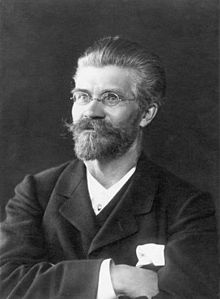Amandus Adamson
Amandus Heinrich Adamson (born November 12, 1855 in the village of Uuga-Rätsepa near Paldiski , today Harju district ; † June 26, 1929 in Paldiski) was one of the most famous Estonian sculptors .
Early years
Amandus Adamsons was born into a fisherman's family. The boy grew up by the sea, which would later shape his art. From 1862 to 1870 he attended school in Tallinn . His artistic talent was already evident as a child when he made wood carvings and sold them successfully in a Tallinn art shop from 1869. From 1870 to 1873 Amandus Adamson trained with a carpenter in Tallinn before he found employment in the well-known workshop of Bollhagen and Schutow in 1873. From 1876 to 1879 Adamson studied sculpture and sculpture in the studio of Alexander Friedrich von Bock at the St. Petersburg Academy of Art . In his senior year he received the great silver medal from the academy.
freelance artist
After that Amandus Adamson worked as a freelance artist in Saint Petersburg and Estonia . In 1886/87 he was a lecturer at an art school. On April 8, 1887, his first exhibition opened in Saint Petersburg. From 1887 to 1891 he continued his education in Paris , later also in Italy . The work of Jules Dalou and Jean-Baptiste Carpeaux in particular shaped him during this time. He mainly used wood , bronze and marble as materials . In addition to his famous sculptures and monuments , he also made decorative work . Are known z. B. its friezes and masterfully carved picture frames .
In 1889 Adamson successfully presented his two works Esimene piip and Laine at the World Exhibition in Paris . After that he took part in major exhibitions with further success. In 1891 he moved back to Saint Petersburg, but also often stayed in Paldiski and the Pakri Islands . From 1901 he was more intensively concerned with public monuments. On September 7, 1902, his most famous work was inaugurated in Tallinn, the large Russalka monument in memory of the ship of the same name that sank in 1893.
In 1907, Adamson was awarded the title of Academician of the Petersburg Art Academy in Saint Petersburg . Nikolai Triik and Konrad Mägi are among his most famous students . After the October Revolution in Russia and Estonia's independence, Amandus Adamson settled in Paldiski on the Baltic Sea in 1918 . He lived in the village until his death, interrupted by numerous other stays in Italy .
In 1922 he joined the Central Association of Fine Artists of Estonia ( Eesti Kujutavate Kunstnikkude Keskühing ) and in 1924 the Estonian Artists Association ( Eesti Kunstnikkude Liidu ).
In 1929 Amandus Adamson died of a heart attack in Paldiski and left numerous unfinished jobs here. He is buried in Pärnu at his request . A museum in Paldiski has been dedicated to his life and work since 2005.
Works
- Niobe pea (probably 1875)
- Igavesti võidutsev armastus (1889)
- Külataat Keilast (1893)
- Koit ja Haemarik (1895)
- Kalevipoeg yes Sarvik (1896)
- Hülgekütt Pakri saarelt (1898)
- Laeva viimne ohe (1899)
- Äreval ootel (1899)
- Russalka Memorial in Tallinn district Kadriorg (1902)
- Sculptures on the facade of the Yelissejew deli and the Singer House in Saint Petersburg (1903 and 1904, respectively)
- Champion (1904, gold medal in the art discipline at the 1904 Summer Olympics in St. Louis with a depiction of the Estonian wrestler Georg Lurich )
- Monument to the Sunk Ships in Sevastopol (1904)
- Memorial to the Zaporozhian Cossacks who landed in Taman in 1792 (1911)
- Bust of Johann Koeler (1911, since 1913 on Koeler's tomb in Suure-Jaani )
- Noorus Kaob (1919)
- Nälg (1920)
- Kalevipoeg Põrgu väravas (1922)
- Memorial to Friedrich Reinhold Kreutzwald in Võru (1926)
- Memorial to the inhabitants of Saaremaa in Kuressaare who died in the Estonian War of Freedom (1928, destroyed by the Soviet occupation authorities in 1945, restored in 1989)
- Monument to Lydia Koidula in Pärnu (1929)
literature
- Heini Paas: Amandus Adamson 1855-1929 . Tallinn: Eesti Art Museum 2007
Web links
- Wilhelm Neumann Lexicon of Baltic Artists, Riga 1908
- Amandus Adamson Museum in Paldiski ( Memento from June 15, 2006 in the Internet Archive )
- Complete list of works ( Memento from June 7, 2008 in the Internet Archive )
- Life and Work ( Memento from April 15, 2008 in the Internet Archive ) (Estonian)
- Biography (Estonian)
- Special stamp of the Estonian Post ( Memento of September 28, 2007 in the Internet Archive )
| personal data | |
|---|---|
| SURNAME | Adamson, Amandus |
| ALTERNATIVE NAMES | Adamson, Amandus Heinrich |
| BRIEF DESCRIPTION | Estonian sculptor |
| DATE OF BIRTH | November 12, 1855 |
| PLACE OF BIRTH | Uuga-Rätsepa village near Paldiski , today Harju County , Estonia |
| DATE OF DEATH | June 26, 1929 |
| Place of death | Paldiski |



